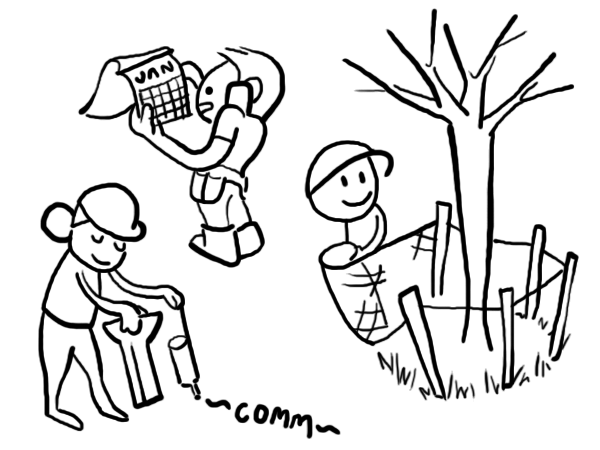Planning, Scheduling, and Management
Before starting construction, it’s important to determine which people or organizations might be affected by the construction process, and to let them know when it will happen. This will also help to identify any potential problems you might run into before they happen. Transit companies, sanitation companies, mail delivery services, and other groups are some examples of who you should contact before beginning.
A preconstruction meeting will help you organize and prepare for construction. This meeting should involve the design team, contractor, representatives from your school board, your PAC (Parent Advisory Council), and anyone else involved in organizing the project. You’ll go over coordination between contractors, material delivery schedules and staging, on-site work, and phasing and completion timelines, which will help to develop a schedule of construction work.
Locating Utilities
It’s important to know where all of the underground utilities are before digging. A local utility company must be called to locate all utilities and to mark them with colours representing what they are:
- Red: electric
- Yellow: gas/oil/steam
- Orange: communications/cable TV
- Blue: water
- Green: sewer
- White: marks the boundaries of the area to be excavated
- Pink: temporary survey markings
These marks are quite accurate but have a margin of error of about 1 foot, so care must be taken to not damage any of these systems when digging close to their markers.
Construction Preparation
- Site Security
- Safety is an important factor in any construction site, but especially where children are concerned. Playground equipment and other elements stored on site can be a novelty and attraction for kids, and should be protected and fenced off to keep kids away from any hazards.
- Erosion Control
- When the digging starts, loose soil can be easily washed out by rain or moved by the wind, potentially getting silt into local waterways and damaging ecosystems. The construction team may use a combination of erosion control fencing, bales of straw placed in drainage channels, or special fabrics that are put over openings to catch basins that filter out fine sediments.
- Protecting Trees and Other Elements
- Trees can be easily damaged by construction activity, and need to be fenced off to protect their trunks and roots. Root systems can be even larger than the tree itself, so a good rule of thumb is to fence off the entire area under a tree up to its drip line. Other planted areas may need protection, as well as areas close to buildings to protect existing structures from damage.
Demolition
Time to clear out anything that won’t be in the finished design! Where possible, materials from demolished elements can and should be reused. This not only keeps material out of the landfill; if used in the new project, it can reduce the overall cost. The following page will explain this process in more depth. In addition, see Recycled Recreation for some examples of creative uses of recycled materials.
Site Preparation
If large machinery will be needed, gravel may be laid for truck routes. Utilities might be moved if they interfere with the construction. Soil might be tested to check how much weight it can handle for larger structures, how likely it will be to have erosion issues, and its level of fertility for planting.
Layout
After everything else is ready, the site will be measured and marked, laying out every major item and element shown in the construction drawings. This will include site boundaries, catch basins, foundation corners, and other primary elements. Grading stakes will also be placed at important spots. These will be used for placing formwork.
